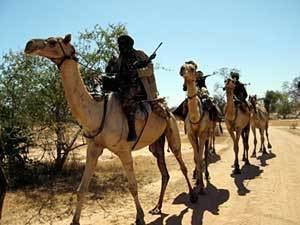Dates of operation 1987 - present | Status Active Active region North Africa | |
 | ||
Ideology Arab Ethnic nationalism (Arabocentric) Size Unknown about 8 average (less than 25,000 est.) | ||
The Janjaweed (Arabic: جنجويد janjawīd; also transliterated Janjawid) are a militia that operate in western Sudan and eastern Chad. Using the United Nations definition, the Janjaweed comprised Sudanese Arab tribes, the core of whom are from the Abbala (camel herder) background with significant recruitment from the Baggara (cattle herder) people. This UN definition may not necessarily be accurate, as instances of members from other tribes have been noted.
Contents

In the past, they were at odds with Darfur's sedentary population over natural grazing grounds and farmland, as rainfall dwindled and water became scarce. They are currently in conflict with Darfur rebel groups—the Sudan Liberation Movement/Army and the Justice and Equality Movement. Since 2003 they have been one of the main players in the Darfur conflict, which has pitted the largely nomadic tribes against the sedentary population of the region in a battle over resource and land allocation.

Janjaweed darfur soudan original footage
Etymology

The origin of the word Janjaweed is unclear. It has been translated into English as "devils on horseback" from the Arabic words جن jinn "demon" and أَجَاوِيد 'ajāwīd "horses". Other sources suggest its origin comes from the Persian word جنگوی jangawi, meaning "warrior", or a portmanteau of three words: جَن jan, after English "gun"; jinn; and 'ajawīd.
History
In 1972, Muammar al-Gaddafi created the Islamic Legion as a tool to unify and Arabize the region. The priority of the Legion was first Chad, and then Sudan.
In Darfur, a western province of Sudan, Gaddafi supported the creation of the Arab Gathering (Tajammu al-Arabi), which according to Gérard Prunier was "a militantly racist and pan-Arabist organization which stressed the 'Arab' character of the province." The two organizations shared members and a source of support, and the distinction between the two is often ambiguous.
The nearly continuous cross-border raids that resulted greatly contributed to a separate ethnic conflict within Darfur that killed about 9,000 people between 1985 and 1988. The Janjaweed leadership has some background in Gaddafi's mercenaries.
The Janjaweed first appeared in 1988 after Chadian President Hissène Habré, backed by France and the United States, defeated the Libyan army, thereby ending Col. Muammar al-Gaddafi’s territorial designs on Chad. Gaddafi’s Chadian protégé, Acheickh Ibn Omer Saeed, retreated with his partisan forces to Darfur, where they were hosted by Sheikh Musa Hilal, the newly elevated chief of the Rizeigat Arab tribes of north Darfur. Hilal’s tribesmen had earlier smuggled Libyan weapons to Ibn Omer’s forces. A French-Chadian incursion destroyed Ibn Omer’s camp, but his weapons remained with his Mahamid hosts.
Throughout the 1990s, the Janjaweed were Arab partisans, tolerated by the Sudan Government, who pursued local agendas of controlling land. The majority of Darfur’s Arabs, the Baggara confederation, began their presence in the war over grazing territory, and remain involved. In 1999-2000, faced with threats of insurgencies in Western and Northern Darfur, Khartoum’s security armed the Janjaweed forces.
When the insurgency escalated in February 2003, spearheaded by the Sudan Liberation Movement/Army, and the Justice and Equality Movement, the Sudanese Government responded by using the Janjaweed as its main counter-insurgency force. Protracting the forces to attack and recover the rebel held areas of Darfur, the Janjaweed conducted a campaign targeting rebels in the region of Darfur. The U.S. State Department and others in 2004 named leading Janjaweed commanders, including Musa Hilal as suspected genocide criminals. By early 2006, many Janjaweed had been absorbed into the Sudan Armed Forces including the Popular Defense Forces and Border Guards. Meanwhile, the Janjaweed expanded to include some Arab tribes in eastern Darfur, not historically associated with the original Janjaweed. Chadian Arabs were also increasingly active in seeking to reestablish a political base in Chad, as part of the Unified Forces for a Democratic Change (FUC) coalition.
By October 2007, only the United States' government had declared the Janjaweed killings in Darfur to be genocide, since they had killed an estimated 200,000-400,000 civilians over the previous three years. The UN Security Council called for the Janjaweed to be disarmed. On July 14, 2008 the prosecutor of the International Criminal Court filed genocide charges against Sudanese President Omar al-Bashir, accusing him of masterminding attempts to wipe out African tribes in Darfur with a campaign of murder, rape and deportation using the Janjaweed tribes.
Janjaweed's commanders
Musa Hilal, who heads a small but powerful Darfurian Arab tribe, is suspected by the US State Department of being a leader of the Janjaweed. The New Yorker quotes him: "I am a tribal leader. ... The government call to arms is carried out through the tribal leaders." He admits recruiting, but denies being in the military chain of command, according to Human Rights Watch.
The following is a United States State Department list of Janjaweed Commanders and Coordinators:
The following is a United States Congress list of Janjaweed's Coordination and Command Council:
The following is a United States Congress list of Janjaweed Field Command:
International Criminal Court Other members:
